

Downloadable Materials — The Learning Scientists. About the six strategies for effective learning resources: These resources were created based on research from cognitive psychology from the past few decades.
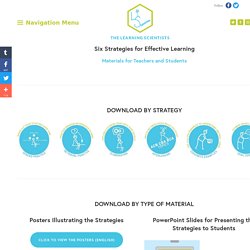
To learn more about how we created the materials, see this blog. The materials are intended to teach about principles of learning and to provide teachers and students with flexible guiding principles to guide learning and studying. However, they are not intended to fix all problems within education. Further, we cannot guarantee success, and we cannot predict students' grades based on the use of these strategies. Fair use of the materials: Vocabulary activities. Teaching Strategies to Enhance Memorization. The memory demands of school-aged children are more regimented then they were a decade ago.

While many schools’ main teaching strategies are not mainly on memorization, but more on higher-order thinking skills, the ability to memorize information is still vastly important. Children are constantly being inundated in the classroom with information on new topics and concepts. While some children may find it to be easy to recall words or math facts in an instant, others’ short-term memory may find it more difficult. Luckily, there are teaching strategies that you can use to enhance their memory. Try integrating the following teaching strategies into your curriculum to help your students develop a more efficient memory. Mnemonic Devices. Seven Challenges for Open Mobile Vocabulary Learning - DRAFT for IKASNABAR 2014.
English Profile - Text Inspector. Questioning That Deepens Comprehension. Editor's note: This post is co-authored by Nancy Frey, a Professor of Literacy in Educational Leadership at San Diego State University and a credentialed special educator, reading specialist, and administrator.
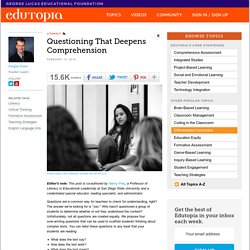
Questions are a common way for teachers to check for understanding, right? The answer we’re looking for is "yes. " Who hasn't questioned a group of students to determine whether or not they understood the content? Unfortunately, not all questions are created equally. We propose four over-arching questions that can be used to scaffold students' thinking about complex texts. What does the text say? Edutopia. Every teacher I've worked with over the last five years recalls two kinds of digital experiences with students.
The first I think of as digital native moments, when a student uses a piece of technology with almost eerie intuitiveness. As digital natives, today's teens have grown up with these tools and have assimilated their logic. Young people just seem to understand when to click and drag or copy and paste, and how to move, merge and mix digital elements. The second I call digital naiveté moments, when a student trusts a source of information that is obviously unreliable. Strategies to Build Intrinsic Motivation. Punishment, Rewards, and Commitment The issue with classroom management policies in most institutions is that it operates on a carrot-and-stick model.
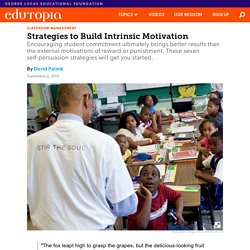
Carrots include PBIS (Positive Behavior Intervention and Supports), Classroom Economy, and other class rewards. Sticks include punishment such as detention, suspension, or withholding from other activities. Teachers and educational leaders believe that these measures will help control the students. However, self-persuasion produces more powerful and longer-lasting benefits than direct techniques of persuasion produce. The goal of self-persuasion is to create cognitive dissonance in the mind of the one being persuaded. Punishment In 1965, Jonathan Freedman conducted a study in which he presented preschoolers with an attractive, desired, "Forbidden Toy.
" Weeks later, Freedman pulled the students out of class one by one and had them do a drawing test. Rewards. Observation, Assessment and Planning - Early Years Matters. The EYFS Profile summarises and describes children’s attainment at the end of the EYFS. It is based on on-going observation and assessment in the three prime and four specific areas of learning, and the three learning characteristics, set out below: The prime areas of learning: • communication and language • physical development.
Pre-birth to Three: Observation, Assessment and Planning. Why Empathy Holds the Key to Transforming 21st Century Learning. By Thom Markham Like other aspects of modern life, education can make the head hurt.
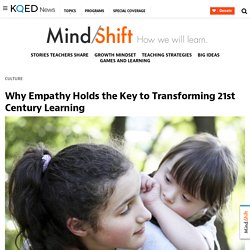
So many outcomes, so much important work to do, so many solutions and strategies, so many variations on teaching, so many different kinds of students with so many different needs, so many unknowns in preparing for 21st Century life and the endless list of jobs that haven’t been invented. Which Early Childhood Experiences Shape Adult Life? By Maanvi Singh, NPR Most of us don’t remember our first two or three years of life — but our earliest experiences may stick with us for years and continue to influence us well into adulthood.
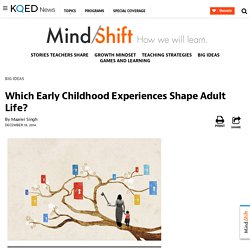
Can Free Play Prevent Depression and Anxiety In Kids? Over the past 50-60 years, play time in kids’ lives has been drastically cut.

School days and years are longer and parents often schedule enrichment activities for their children instead of giving them space to direct their own play. Children are rarely given the freedom to direct their own activities, leading to a persistent rise in children feeling that they have no control over their lives. And, while correlation doesn’t prove causation, Dr. Peter Gray, who has been studying play for years, says there’s strong evidence that in this case, the decline in play is leading to a rise in depression and acute anxiety among young people.
Check out his TEDx talk for all the details on this fascinating area of research. Don't Expect Toddlers To Behave Consistently — They Literally Can't. One theory all teachers with disruptive children should know about. Imagine a classroom where children are unable to wait their turn or stay focused on their work.
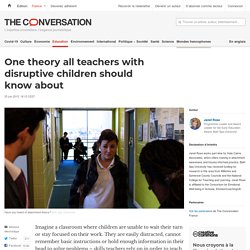
They are easily distracted, cannot remember basic instructions or hold enough information in their head to solve problems – skills teachers rely on in order to teach successfully. These behavioural issues are all examples of problems that can arise from attachment issues – based on the relationship between children and their main caregiver. Attachment theory is now one of the world’s most well-researched theories about human development. Positive Learning Environment - Primary. Key Person & Attachment - Early Years Matters. The Key Person Children thrive from a base of loving and secure relationships. This is normally provided by a child’s parents but it can also be provided by a key person. A key person is a named member of staff with responsibilities for a small group of children who helps those children in the group feel safe and cared for.
The role is an important one and an approach set out in the EYFS which is working successfully in settings and in Reception classes. It involves the key person in responding sensitively to children’s feelings and behaviours and meeting emotional needs by giving reassurance, such as when they are new to a setting or class, and supporting the child’s well-being. How Are Happiness and Learning Connected? As teachers, we also know that when students' affective filters or defenses are sky high, fight or flight responses will be modus operandi. A room full of defensive behaviors (withdrawn, angry) is a sad, unproductive place to teach and learn.
Now let's flip it and take a look at how much more we are able to learn when we are in harmony with the people and things in any given educational environment. Being in harmony means feeling safe, feeling valued and a necessary part a group, and in this case, a learning community. One theory all teachers with disruptive children should know about. Learning Time with Shaun & Timmy - British Council - Accueil. What to consider when teaching English in large classes. How many students do you teach? Do you feel that your classes are too big? Author and education consultant Jason Anderson looks at the issues and offers some potential solutions. For many of us, our classes are larger than we would like them to be. They can present a number of challenges that teachers of smaller classes are less likely to face.
But what exactly do we mean by large classes? Whole Child Development Is Undervalued. The question is how to make such an approach both systemic and sustainable. Whole Person Socio-emotional, physical, creative, and cognitive capacities are deeply intertwined and equally important in ensuring a child's wellbeing, learning, and growth. (That shouldn't be a surprise to anyone studying or supporting children's learning.) Nobel laureate James Heckman, a professor of economics at the University of Chicago, has shown that the non-cognitive skills emerging in early childhood are among the strongest predictors of adult outcomes. And Paul Tough, author of How Children Succeed, has continued to emphasize the crucial role that soft skills play in character formation and building on persistence, curiosity, and even grit -- the "passion and perseverance for very long-term goals," according to psychologist Angela Lee Duckworth.
The most impactful way of supporting such skills is associated with helping children feel in control of their learning process. Whole Communities. School Radio - Nursery songs and rhymes. Music and Movement Activities for Toddlers and Preschoolers. 45+ Quick & Easy Kids Crafts that ANYONE Can Make! LearnEnglish Kids. LearnEnglish Kids. How to teach children English using illustrated storybooks. What makes illustrated storybooks such a good resource for teaching young learners of English? The British Council’s Gail Ellis, co-author of a storytelling handbook for primary English language teachers, explains.
Practical tips. By Opal Dunn, educational consultant and author Introduction Young children learn English differently from most adults.
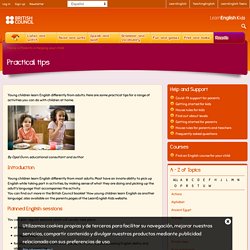
Most have an innate ability to pick up English while taking part in activities, by making sense of what they are doing and picking up the adult’s language that accompanies the activity. You can find out more in the British Council booklet ‘How young children learn English as another language’, also available on the parents pages of the LearnEnglish Kids website. Planned English sessions You can plan regular sessions which will usually take place: Ten ways to support your child’s English-learning at home. 5 Examples of Onomatopoeia. Onomatopoeia is a fun, linguistic tool used in literature, songs and advertisements.
Effective Teacher-Child Interactions. Carol Dweck: The power of believing that you can improve. How can parents and teachers best educate young children? Nihms 375055. Listening Skills for Staff. The Power (and Peril) of Praising Your Kids. Nihms416960. Selective mutism. Selective mutism is a severe anxiety disorder where a person is unable to speak in certain social situations, such as with classmates at school or to relatives they don't see very often.

It usually starts during childhood and, left untreated, can persist into adulthood. A child or adult with selective mutism doesn't refuse or choose not to speak, they're literally unable to speak. Teaching English to learners with Special Educational Needs (SENs) – Myths and realities. Neurodiversity TfS online conference. Inclusion Development Programme Behaviour Emotional Social Difficulties. B480 Special Need Publication A4 V5 Final MR. Being Multilingual: You speak with an accent. I don’t.
Accents are things that only other people have. They are, by extension, things that you don’t want to have. Being Multilingual: The natives and the speakers. Let me start with the good news. We are, all of us without exception, native speakers. This may come as a surprise to those of us who have had close encounters with the second/foreign language world, but is nonetheless true. I Said I Want the Red Bowl! Responding to Toddlers' Irrational Behavior. Pin It. Schemas in Children’s Play - N a t u r e P l a y. The benefits of toy blocks.
Play to Learn: Discussion. Infantbehaviouranddevelopment. Plays potential in early literacy development. Play and learning. Symbolic play and language development. Scientists Say Child's Play Helps Build A Better Brain : NPR Ed. The cognitive benefits of play: Effects on the learning brain. Play to Learn. Why play-based learning? (free article) - Early Childhood Australia. Does being bilingual make you smarter? A few more myths about speakers of multiple languages. How Children Learn to Talk.
Earlychildhood NEWS - Article Reading Center. How can young children best learn languages?